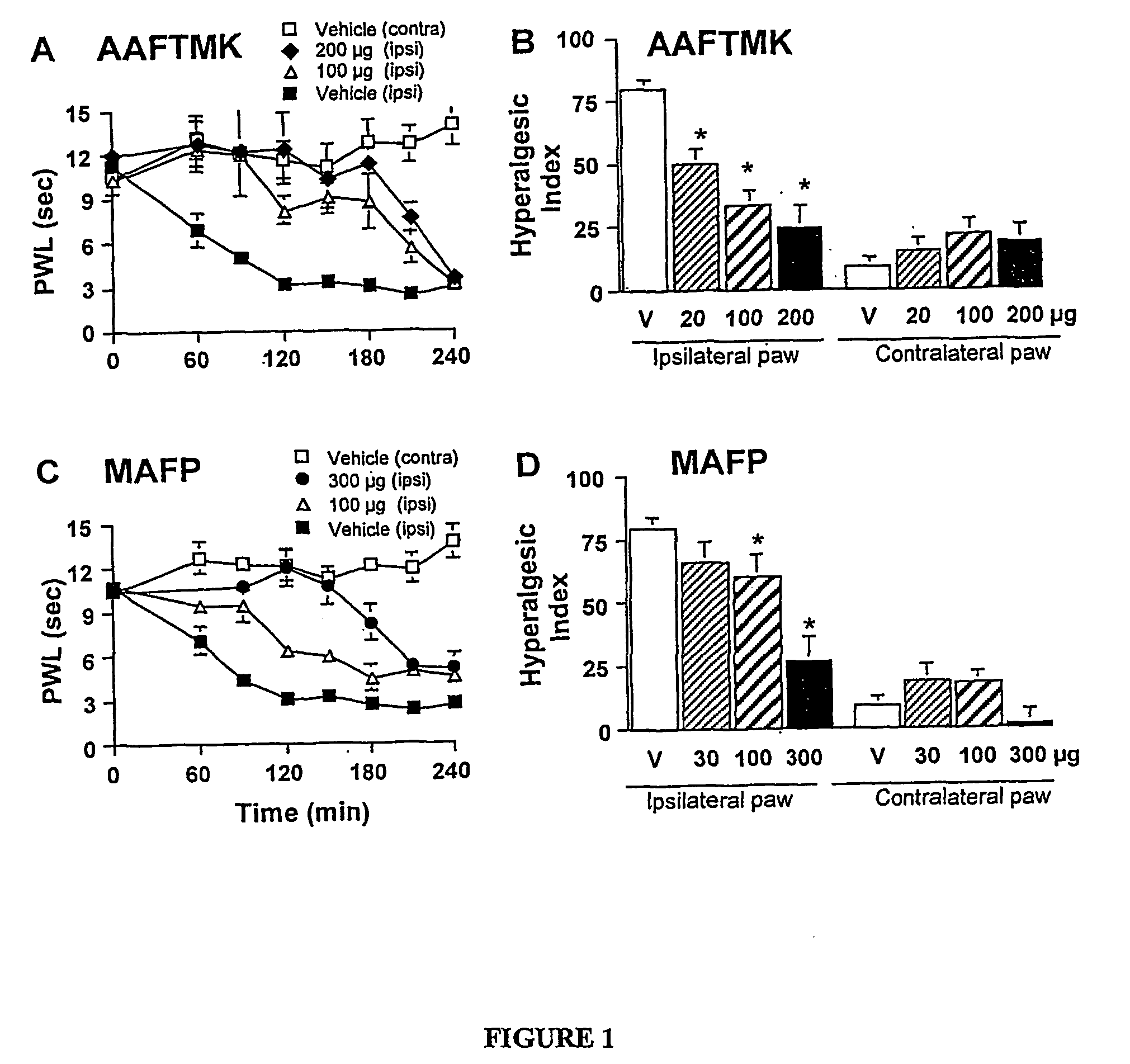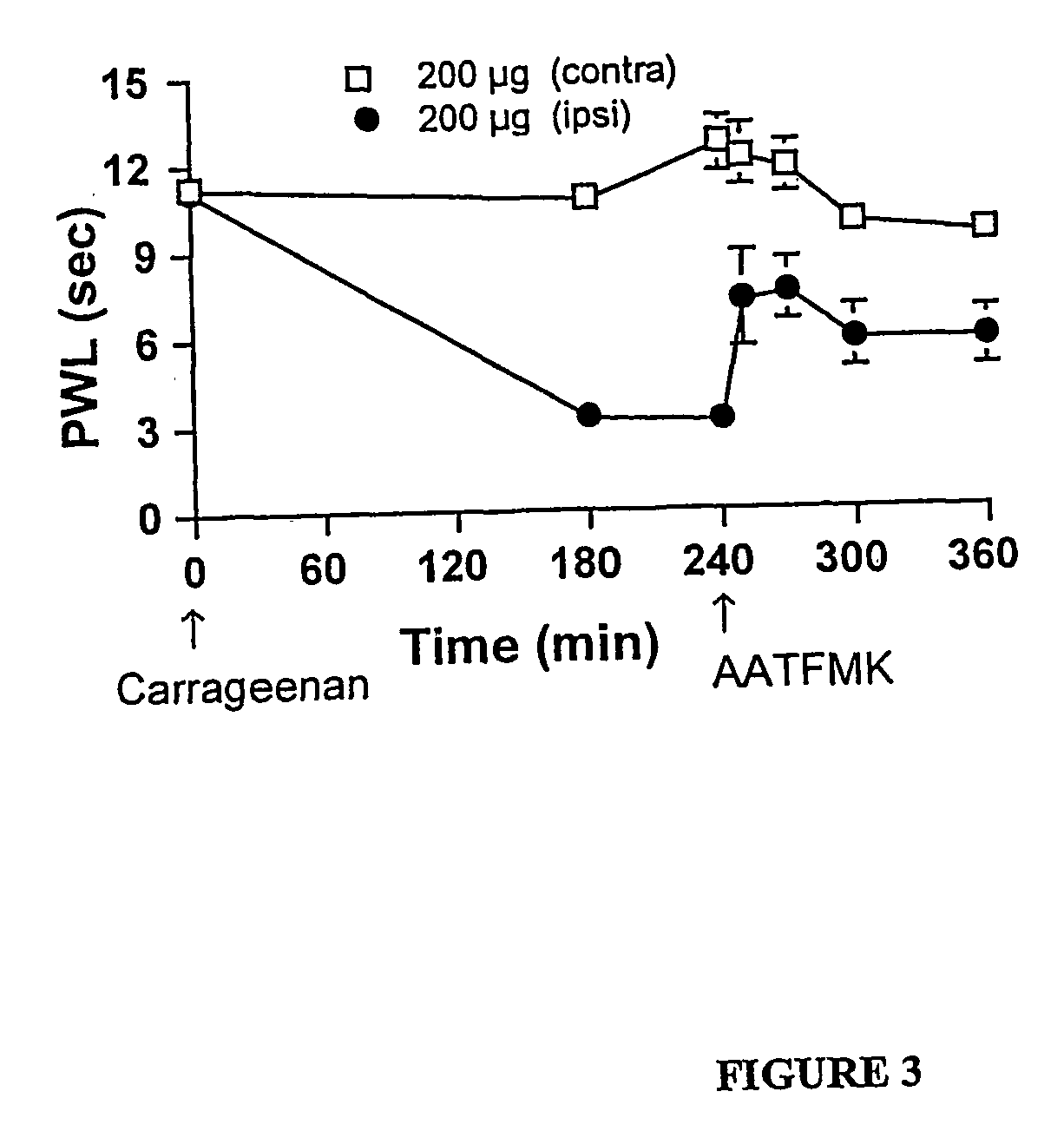Compositions and methods for inhibition of phospholipase a2 mediated inflammation
a phospholipase and enzyme technology, applied in the direction of phosphorous compound active ingredients, drug compositions, group 5/15 element organic compounds, etc., can solve the problem of hypersensitivity to painful stimuli, and achieve the effect of high degree of specificity
- Summary
- Abstract
- Description
- Claims
- Application Information
AI Technical Summary
Problems solved by technology
Method used
Image
Examples
example 1
General Methodology Utilized for Ex Vivo Experiments
[0125] Animals: Experiments were carried out according to protocols approved by the Institutional Animal Care Committee of University of California, San Diego. Male Holtzman Sprague-Dawley rats (250-350 g; Harlan Industries) were housed pair-wise in cages and maintained on a 12-hr light / dark cycle with free access to food and water at all times.
[0126] Intrathecal catheter implantation: For intrathecal drug delivery, chronic lumbar catheters were implanted in rats under isoflurane anesthesia according to a modification of the procedure described by Yaksh (Yaksh and Rudy, 1976). A polyethylene catheter (PE-10) was inserted through an incision in the atlanto-occipital membrane and advanced caudally to the rostral edge of the lumbar enlargement. Studies involving rats with chronic IT catheters were carried out 5 days after implantation, and rats were housed individually after implantation under the same conditions described above. Ex...
example 2
Intrathecal PLA2 Inhibitors Prevented Carrageenan-Induced Thermal Hyperalgesia
[0142] Carrageenan induces a characteristic inflammation and associated thermal hyperalgesia. Baseline latencies were assessed for all animals before injection of carrageenan and the average time to response was 11.1±0.4 seconds for the left hind paw (ipsilateral) and 10.6±0.7 seconds for the right hind paw (contralateral). After carrageenan injection into the plantar side of the left hind paw a reduction in time to paw withdrawal was detected. The withdrawal latency time decreased to 3.2±0.7 seconds at 120 minutes after carrageenan injection (FIG. 1A). There was no change of withdrawal time for either of the two control groups receiving IT saline or IT vehicle (data not shown). Pre-treatment with either IT AATFMK or IT MAFP resulted in a potent dose-dependent prevention of carrageenan-induced thermal hyperalgesia (FIGS. 1A and C).
[0143] Importantly, there were no changes in the response latency of the u...
example 3
IT Administration of PLA2 Inhibitors Suppressed Formalin-Induced Flinching
[0150] Injection of formalin into the dorsal side of the right hind paw evokes an initial burst of afferent input followed by a persistent low level discharge. This model predicts a biphasic increase in the activity of dorsal horn wide dynamic range neurons (Haley et al., Brain Res., 518218-226 (1990)) and a parallel biphasic appearance of flinching (FIG. 4) (Yaksh, et al., J. Appl. Physiol., 90: 2386-2402 (2001)). Pretreatment with AAFTMK and MAFP resulted in a dose-dependent reduction of the formalin induced flinching (FIGS. 4A, B and C). While Phase 1 was not significantly affected by the drugs, a statistically significant reduction was seen in Phase 2 (FIG. 4D) when compared to the group that received IT vehicle.
PUM
| Property | Measurement | Unit |
|---|---|---|
| mole fraction | aaaaa | aaaaa |
| volumes | aaaaa | aaaaa |
| volumes | aaaaa | aaaaa |
Abstract
Description
Claims
Application Information
 Login to View More
Login to View More - R&D
- Intellectual Property
- Life Sciences
- Materials
- Tech Scout
- Unparalleled Data Quality
- Higher Quality Content
- 60% Fewer Hallucinations
Browse by: Latest US Patents, China's latest patents, Technical Efficacy Thesaurus, Application Domain, Technology Topic, Popular Technical Reports.
© 2025 PatSnap. All rights reserved.Legal|Privacy policy|Modern Slavery Act Transparency Statement|Sitemap|About US| Contact US: help@patsnap.com



